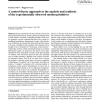Free Online Productivity Tools
i2Speak
i2Symbol
i2OCR
iTex2Img
iWeb2Print
iWeb2Shot
i2Type
iPdf2Split
iPdf2Merge
i2Bopomofo
i2Arabic
i2Style
i2Image
i2PDF
iLatex2Rtf
Sci2ools
BC
2005
2005
A control theory approach to the analysis and synthesis of the experimentally observed motion primitives
Recent experiments on frogs and rats, have led to the hypothesis that sensory-motor systems are organized into a finite number of linearly combinable modules; each module generates a motor command that drives the system to a predefined equilibrium. Surprisingly, in spite of the infiniteness of different movements that can be realized, there seems to be only a handful of these modules. The structure can be thought of as a vocabulary of "elementary control actions". Admissible controls, which in principle belong to an infinite dimensional space, are reduced to the linear vector space spanned by these elementary controls. In the present paper we address some theoretical questions that arise naturally once a similar structure is applied to the control of nonlinear kinematic chains. First of all, we show how to choose the modules so that the system does not loose its capability of generating a "complete" set of movements. Secondly, we realize a "complete" vocab...
| Added | 15 Dec 2010 |
| Updated | 15 Dec 2010 |
| Type | Journal |
| Year | 2005 |
| Where | BC |
| Authors | Francesco Nori, Ruggero Frezza |
Comments (0)

